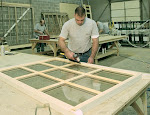The LEED Program's Green is Beginning to Turn Brown
As I was riding my bike to work this morning in 82 degree
temperatures, I thought about how silly it was that you could get an extra
point towards a LEED certification for having a bike rack. I didn’t need a bike
rack when I arrived at my plant, I needed a shower. Or shall I say, my
employees needed for me to take a shower. This made me reflect upon how little
I have seen LEED related projects on the drawing boards for new projects. What
was once the great movement that was touted by all in the construction industry
as a revolutionary way to consider construction, is now becoming a waning
fad just like granite counter tops and brightly colored Croc shoes. How has the
LEED program met with such a precipitous decline?
I wrote a post over two years ago about how the construction
industry needed to wake up and see that the LEED program was adding very little
value to the construction process. At the time, LEED was very popular and I
felt like I was being heretical to oppose such a venerable institution. I
certainly wouldn’t want to be perceived to be an irresponsible capitalist who
scoffs at construction stewardship. Back in 2012, the LEED program was having a
profound effect on realigning priorities in the construction industry and
changing the way we looked at energy consumption and resource utilization.
Architects were standing in line to gain certification and building owners were
jumping through hoops to achieve a platinum level certification. I felt that
the program had grown to the point where the costs were beginning to exceed the
benefits. Here we are in 2015 and all that hype has dissipated because of a
number of factors.
After you suffer through a LEED certified project, you have
a better understanding of what costs are associated with achieving such a
designation. The costs of registering the project are just the beginning. Most
people who are experienced with the certification complain about the massive
administrative costs associated with documenting compliance. Other costs such
as increased design expenses, energy modeling, installation of monitoring
devices, and testing that has become part of LEED’s latest version add a
substantial amount to the project. Finally, we have the cost of construction which
is amplified by demanding features such as FSC-certified wood and local sources
for building materials that restrict one’s ability to source equal products at
a lower cost. Some estimate that pursuing a LEED certification can increase the
total cost of construction by over $1 per square foot.
The administrative burden is another reason that LEED has
lost popularity. Everyone in the construction process from the owner, designer,
contractor, subcontractors, and suppliers spend thousands of hours to research
alternatives and provide documentation in an effort to meet the requirements. The
last thing our industry needs right now is another reason to delay
construction. For instance, our company has to spend one complete day per year
to undergo a Forest Stewardship Council (FSC) certification to be able to
provide the required FSC wood for a LEED project. It became such an exercise in
nonsense, I recently told FSC we would pass on the renewal this year. If we run
into a LEED project that demands FSC wood in the future, I will apply any associated
fees to the costs of the project.
Let’s face it, from 2000 to 2012 it was exciting to get on
the LEED bandwagon. The construction industry was in the dumps and everyone was
looking for something to distinguish their company in a desperate attempt to
generate revenues. Building owners were willing to pay more to brand their
structure as LEED certified. Developers could charge more per square foot,
corporations could benefit from positive public relations, and suppliers could
charge more for certified materials. LEED gave the industry new hope during a
lethal recession. We find ourselves in a different position today. Since there
are over 50,000 buildings that have been certified over the years, the panache
associated with a gold or platinum level certification has significantly
diminished. The survivors of the poor economy have climbed out of the
recessionary doldrums and are back to work. The last thing we are looking for
now is a program that offers additional cost with little benefit.
In an attempt to keep growing in popularity and become more
than just a passing fad, LEED attempted to justify its program by producing a
biased study of the benefits of certification. The New Building Institute (NBI)
produced a study documenting the difference in energy consumption between LEED-certified
buildings and existing construction stock. NBI concluded that LEED buildings
were 25-30% more energy efficient relative to conventional buildings. Very few
people are aware that NBI is a non-profit largely funded by the USGBC which is
responsible for LEED, or that the board of directors of NBI has members from
the USGBC, When the study was evaluated by independent agencies, they concluded
that there are no significant reductions in LEED buildings compared to similar
structures. So why go through the pain of certification if there is no real
benefit?
In conclusion, I think the LEED program will be looked at as
that moment of excitement when the industry was reeling from one of the worst
recessions in history. The stockholders of the USGBC will retire with their
millions generated from the program, and architects will have to print new
business cards without the LEED professional certification. Hopefully the
industry will remember some of the valuable principles outlined in the program
so we can continue to construct outstanding buildings.
I think it’s time for a shower. The flies are starting to
take over my office and people are avoiding me.






No comments:
Post a Comment